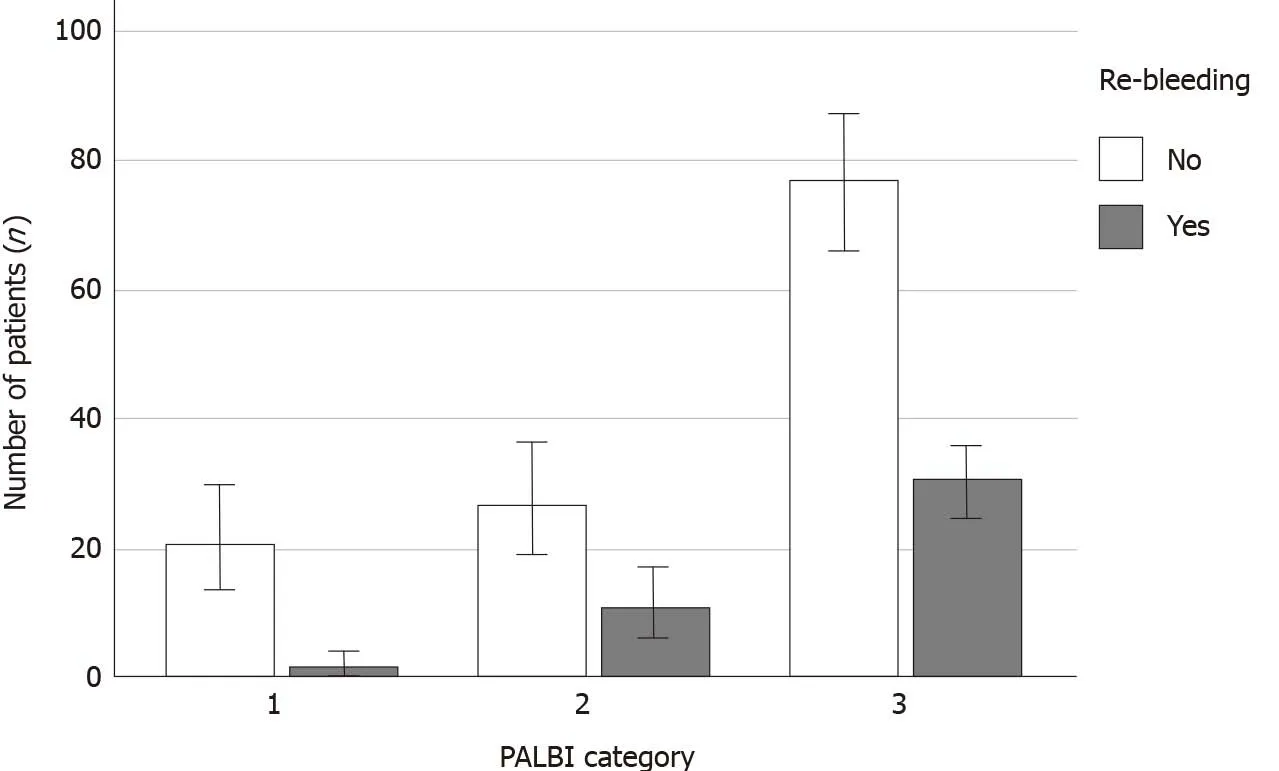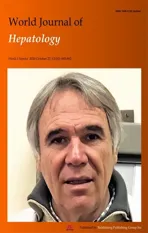Role of platelet-albumin-bilirubin score in predicting re-bleeding after band ligation for acute variceal hemorrhage
2021-01-14MuhammadFaisalTavankitSinghHinaAminJamakModaresiEsfeh
Muhammad S Faisal, Tavankit Singh, Hina Amin, Jamak Modaresi Esfeh
Muhammad S Faisal, Department of Internal Medicine, Cleveland Clinic, Cleveland, OH 44195, United States
Tavankit Singh, Hina Amin, Jamak Modaresi Esfeh, Department of Gastroenterology and Hepatology, Cleveland Clinic, Cleveland, OH 44195, United States
Abstract Platelet-albumin-bilirubin (PALBI) score was proposed by Roayaie et al with modification of previously studied albumin-bilirubin score to include platelet as an indicator of portal hypertension in 2015.Predictive value of this score was recently tested by Elshaarawy et al for re-bleeding in patients presenting with acute variceal hemorrhage.We did a similar study at our center (n = 170) to look at incidence of re-bleeding after band ligation defined as drop in 2 units of hemoglobin and witnessed melena or hematemesis within 2 wk of the procedure.We calculated PALBI scores for all patients based on lab values prior to the procedure.Of 25.3% had re-bleeding episodes, area under receiver operating characteristic curve for PALBI as predictor of re-bleeding was 0.601 (95% confidence interval: 0.502-0.699).PALBI score showed moderate accuracy at predicting re-bleeding in our population.
Key Words: Cirrhosis; Band ligation; Portal hypertension; Ascites; Platelet-albuminbilirubin; Model of end stage liver disease
TO THE EDITOR
We read with great interest article by Elshaarawyet al[1]regarding the role of plateletalbumin-bilirubin (PALBI) score in predicting re-bleeding and in-patient mortality for patients presenting with acute variceal hemorrhage[1].The authors found that area under receiver operating characteristic (AUROC) for PALBI with outcome of rebleeding was 0.794.This was higher than Child-Turcot-Pugh (CTP), Model of End Stage Liver Disease and Albumin-Bilirubin (ALBI) scores, which were 0.681, 0.74 and 0.766, respectively.PALBI score was proposed by Roayaieet al[2]with modification of previously proposed ALBI score to include platelet as an indicator of portal hypertension in 2015[2].It has been studied as a predictor of liver transplant outcomes[3], rate of decompensation in compensated cirrhosis[4], outcomes of locoregional treatment for liver cancer[5]and now for re-bleeding after acute variceal hemorrhage.
We did a similar study at our center and calculated the PALBI score to validate this data.Our study comprised of 170 patients with a diagnosis of cirrhosis who presented with acute variceal hemorrhage and underwent esophageal variceal band ligation from 2017 to 2018.Of our patients, 18.8% were CTP-A, 48.2% CTP-B and 32.9% CTP-C.In comparison, Elshaarawyet al[1]had 4.5% CTP-A, 29.2% CTP-B and 66.8% CTP-C patients.Our outcome of interest was re-bleeding with the definition proposed byBaveno VI: Drop in two units of hemoglobin along with hematemesis or melena observed clinically within 2 wk of the procedure.25.3% had re-bleeding in our population based on this definition.12.1%, 22.6% and 64.3% of our patients qualified for PALBI category 1 (score ≤ -2.53), 2 (score > -2.53 and ≤ -2.09) and 3 (score >-2.09) respectively.
AUROC for PALBI score in predicting re-bleeding was calculated to be 0.601 (95% confidence interval: 0.502-0.699) and the curve is shown in Figure 1.This indicates moderate quality at best of the PALBI score in predicting re-bleeding after band ligation.This is lower than the reported AUROC by Elshaarawyet al[1]by 24.3%.4.5% of re-bleeders in our cohort belonged to PALBI category 1, 28.9% to PALBI category 2 and 28.7% to PALBI category 3.Rates of re-bleeding in each category are shown in Figure 2.
We found PALBI score to be relatively less accurate than reported by Elshaarawyet al[1]in predicting re-bleeding after band ligation.This discrepancy can be due to differences in the size and characteristics of patient population and definition of the outcome.We only included patients who underwent band ligation for acute variceal hemorrhage from esophageal varices.In contrast, only 51.7% of Elshaarawyet al[1]underwent band ligation alone as treatment for variceal hemorrhage.Their outcome of interest was re-bleeding within 5 d, but we evaluated for re-bleeding within 2 wk following the procedure.Both studies were limited by retrospective design, small number of patients and data from a single institution.
In conclusion, PALBI score is a promising tool for predicting re-bleeding after initial presentation with acute variceal hemorrhage.More data is needed to validate its use in clinical settings post band ligation procedure.

Figure 1 Receiver operating characteristic curve for platelet-albumin-bilirubin score and occurrence of re-bleeding.

Figure 2 Comparison of different platelet-albumin-bilirubin categories with regards to number of patients who had re-bleeding.
杂志排行
World Journal of Hepatology的其它文章
- Neoadjuvant treatment strategies for intrahepatic cholangiocarcinoma
- Metabolic syndrome and liver disease in the era of bariatric surgery: What you need to know!
- Combined liver-kidney transplantation for rare diseases
- Hepatocellular carcinoma Liver Imaging Reporting and Data Systems treatment response assessment: Lessons learned and future directions
- Tumor necrosis family receptor superfamily member 9/tumor necrosis factor receptor-associated factor 1 pathway on hepatitis C viral persistence and natural history
- Apatinib as an alternative therapy for advanced hepatocellular carcinoma
